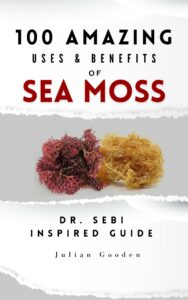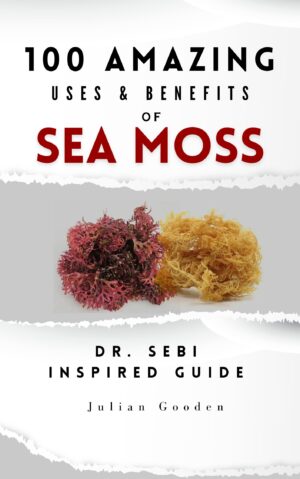Dr. Alfredo Bowman, widely known as Dr. Sebi, was a herbalist and natural healer who revolutionized how we understand health by viewing the human body as an electrical system. Just as a light bulb requires the right electrical current to shine, the body needs specific minerals to maintain its vitality, balance, and capacity for healing. According to Dr. Sebi, the key to optimal health lies in consuming living, plant-based minerals – phosphates, carbonates, iodides, and bromides – sourced from wild plants, herbs, roots, and sea vegetables like sea moss and bladderwrack. These minerals, when derived from natural sources, provide the electrical charge necessary to fuel the body’s nervous system, endocrine glands, tissues, and overall homeostasis. This explanation explores Dr. Sebi’s teachings, the roles of these four mineral families, and their significance in maintaining health.
Living vs. Dead Minerals: A Fundamental Distinction
Dr. Sebi emphasized that not all minerals are equal in their ability to nourish the body. The distinction between living and dead minerals is central to his teachings:
- Living Minerals: These are minerals found in plants, sea vegetables, and other natural, organic sources. They are bioavailable, meaning the body can easily absorb and utilize them due to their electrical structure. Living minerals are arranged in a way that aligns with the body’s cellular processes, providing energy and supporting healing. Examples include minerals from sea moss, dandelion greens, burdock root, and wildcrafted herbs.
- Dead Minerals: These are inorganic or synthetic minerals derived from rocks, laboratory processes, or heavily processed foods. Examples include calcium carbonate tablets, synthetic iodized salt, and phosphate additives in sodas or preservatives. While they may chemically resemble living minerals, dead minerals lack the organic co-factors needed for proper assimilation. Dr. Sebi pointed out that these minerals are not only ineffective but can also harm the body by causing buildup in tissues or disrupting natural processes.
Dr. Sebi advocated for a diet rich in living minerals from whole, plant-based foods to ensure the body receives the electrical energy it needs to thrive. He cautioned against processed foods and synthetic supplements, which he explained could block the body’s electrical pathways and contribute to disease.
Phosphates: Energy for the Nervous System
Phosphates are highly electrical minerals critical for the nervous system’s function and overall energy production. They are essential for maintaining the body’s “wiring,” enabling efficient communication between the brain, nerves, and other systems.
Key Functions of Phosphates
- Fueling Cellular Energy with ATP: Phosphates are a core component of adenosine triphosphate (ATP), the body’s primary energy currency. ATP powers every cellular process, from muscle contraction to nerve signaling. Natural phosphates from plant sources ensure a steady supply of ATP, keeping cells energized and functional.
- Strengthening the Myelin Sheath: The myelin sheath is a protective coating around nerve fibers that enhances the speed and efficiency of nerve signal transmission. Phosphates support the integrity of this sheath, preventing nerve damage and ensuring clear communication throughout the nervous system.
- Supporting Brain-Nerve Communication: Phosphates facilitate smooth signaling between neurons, supporting cognitive functions like memory, focus, and coordination. This makes them vital for mental clarity and overall neurological health.
Dr. Sebi’s Perspective
Dr. Sebi taught that natural phosphates from plant-based sources, such as amaranth, quinoa, dandelion greens, and sea moss, provide the electrical charge needed to energize the brain and nerves. In contrast, synthetic phosphates – commonly found in processed foods like sodas, fast foods, and preservatives (e.g., sodium phosphate) are harmful. These artificial compounds can disrupt cellular function, contribute to inflammation, and weaken the nervous system. By choosing living phosphates, the body’s nervous system remains vibrant, connected, and capable of supporting optimal health.
Natural Sources of Phosphates
- Grains: Amaranth, quinoa, spelt, and teff.
- Leafy Greens: Dandelion greens, kale, and watercress.
- Sea Vegetables: Sea moss and bladderwrack.
- Herbs: Burdock root and nettle.
Carbonates: Maintaining an Alkaline Environment
Carbonates, including natural compounds like calcium carbonate and sodium bicarbonate, are alkaline minerals that help the body resist acid buildup and maintain a balanced pH. An alkaline environment is essential for preventing disease and supporting healing.
Key Functions of Carbonates
- Acting as pH Buffers: Carbonates, particularly bicarbonate ions (HCO₃⁻), are integral to the body’s acid-base buffering system. They neutralize excess acids produced during metabolism, digestion, or exposure to environmental toxins, keeping blood and tissues within the optimal pH range of 7.35 – 7.45. For example, bicarbonate binds with hydrogen ions (H⁺) to form carbonic acid, which is then converted into water and carbon dioxide and expelled through the lungs.
- Strengthening Bones and Tissues: Calcium carbonate, found in natural sources, provides bioavailable calcium that strengthens bones, teeth, and connective tissues. It supports muscle function, nerve signaling, and tissue repair, reducing the risk of conditions like osteoporosis.
- Creating a Healing Environment: An alkaline environment is less hospitable to pathogens, which often thrive in acidic conditions. Carbonates help reduce inflammation, enhance cellular repair, and improve oxygen delivery to tissues, creating conditions conducive to healing and disease prevention.
Dr. Sebi’s Perspective
Dr. Sebi emphasized that carbonates from natural sources, such as sea moss, leafy greens, and alkaline herbs, are vital for maintaining the body’s alkalinity. He strongly opposed inorganic forms of carbonates, such as chalky calcium carbonate supplements, which are poorly absorbed and could lead to calcification in arteries or kidneys. Natural carbonates, in contrast, are accompanied by co-factors that enhance absorption and support the body’s electrical and structural needs.
Natural Sources of Carbonates
- Sea Vegetables: Sea moss, bladderwrack, and dulse.
- Leafy Greens: Kale, spinach, collard greens, and dandelion greens.
- Fruits: Cucumbers, avocados, and limes.
- Herbs: Burdock root, nettle, and sarsaparilla.
- Nuts and Seeds: Sesame seeds and soaked almonds.
Iodides: Nourishing the Endocrine System
Iodides are critical minerals for the endocrine system, which includes glands like the thyroid, pituitary, adrenal, and reproductive glands. These glands regulate energy, hormones, metabolism, fertility, and growth, making iodides essential for overall vitality.
Key Functions of Iodides
- Supporting Thyroid Function: The thyroid gland relies on iodides to produce thyroid hormones (T3 and T4), which regulate metabolism, energy production, and body temperature. A healthy thyroid ensures efficient calorie burning, weight management, and energy levels.
- Balancing the Endocrine Network: By supporting the thyroid, iodides indirectly influence other glands, including the pituitary (which controls hormone production), adrenal glands (which manage stress and energy), and reproductive glands (which regulate fertility and sexual health).
- Enhancing Mental Clarity and Energy: Iodides contribute to cognitive function, mood stability, and mental clarity by ensuring proper hormonal balance and energy metabolism.
Dr. Sebi’s Perspective
Dr. Sebi advocated for natural sources of iodides, such as sea moss and bladderwrack, which provide bioavailable iodine in a form the body can easily use. He warned against inorganic iodized salt, commonly added to table salt, which is harsh and could disrupt the body’s electrical balance. Natural iodides, he noted, harmonize the endocrine system, promoting energy, fertility, and mental focus.
Natural Sources of Iodides
- Sea Vegetables: Sea moss, bladderwrack, and dulse.
- Herbs: Burdock root and Irish moss.
- Vegetables: Watercress and cucumbers.

Bromides: Calming and Restorative Minerals
Bromides are soothing minerals that promote relaxation, repair, and balance in the body. They are particularly valued for their calming effects on the nervous system and their role in tissue restoration.
Key Functions of Bromides
- Calming the Nervous System: Bromides have a sedative effect, helping to reduce stress, anxiety, and nervous tension. They support the parasympathetic nervous system, which promotes rest and recovery.
- Supporting Tissue Repair: Bromides aid in the repair of damaged tissues, making them valuable during recovery from injury, illness, or overexertion.
- Balancing Overworked Systems: By calming overactive nerves and glands, bromides help restore equilibrium to the body, particularly in cases of chronic stress or hormonal imbalances.
Dr. Sebi’s Perspective
Dr. Sebi highlighted sea moss as a cornerstone of his nutritional recommendations due to its high bromide content. He believed bromides were essential for restoring the body’s nervous system and tissues, particularly for individuals recovering from illness or living in high-stress environments. Unlike pharmaceutical sedatives, natural bromides from sea vegetables provide gentle, non-toxic support for relaxation and healing.
Natural Sources of Bromides
- Sea Vegetables: Sea moss, bladderwrack, and dulse.
- Herbs: Nettle and burdock root.
- Fruits: Avocados and bananas (in moderation, as approved by Dr. Sebi’s nutritional guide).
The Electrical Mineral Network: A Holistic System
Together, phosphates, carbonates, iodides, and bromides form an interconnected “electrical mineral network” that supports the body’s vitality and balance:
- Phosphates energize the nervous system, ensuring efficient communication and energy production.
- Carbonates maintain an alkaline environment, buffering acidity and supporting structural health.
- Iodides regulate the endocrine system, harmonizing hormones and metabolism.
- Bromides calm and restore the nervous system and tissues, promoting recovery and balance.
Dr. Sebi taught that these minerals work synergistically to keep the body charged, balanced, and aligned with nature. By consuming foods rich in these living minerals – such as sea moss, bladderwrack, leafy greens, roots, and ancient grains – individuals can support their body’s electrical system and promote optimal health.
Practical Tips for Incorporating Electrical Minerals
To align with Dr. Sebi’s philosophy and nourish the body with living minerals, consider the following practices:
- Incorporate Sea Vegetables: Add sea moss or bladderwrack gel to smoothies, soups, or teas for a potent source of phosphates, carbonates, iodides, and bromides.
- Eat Alkaline Foods: Prioritize leafy greens, alkaline fruits (e.g., cucumbers, avocados), and ancient grains like quinoa and wild rice.
- Avoid Processed Foods: Eliminate acid-forming foods like processed sugars, refined grains, and animal products, which deplete the body’s mineral reserves.
- Use Herbs: Include Dr. Sebi-approved herbs like burdock root, nettle, and sarsaparilla in teas or supplements to boost mineral intake.
- Stay Hydrated: Drink alkaline spring water or herbal teas to support detoxification and pH balance.
- Avoid Synthetic Supplements: Choose whole foods over inorganic mineral supplements, which may lack bioavailability and cause harm.
Scientific Context and Considerations
While Dr. Sebi’s teachings are rooted in wholistic and natural health principles, they sometimes diverge from mainstream medical perspectives. For example:
- Bioavailability of Minerals: Science supports the idea that minerals from plant-based sources are often more bioavailable due to the presence of co-factors. However, inorganic supplements, when properly formulated, can also be effective for addressing deficiencies in certain cases (e.g., calcium carbonate for osteoporosis).
- Alkaline Diet Debate: An alkaline diet rich in fruits and vegetables is widely recognized for reducing inflammation and supporting overall health.
- Iodine and Thyroid Health: The importance of iodine for thyroid function is well-established, but excessive iodine (even from natural sources) can lead to thyroid dysfunction. Moderation and balance are key.
Dr. Sebi’s emphasis on whole, plant-based foods aligns with evidence-based recommendations for a nutrient-dense diet.
Final Thoughts
Phosphates, carbonates, iodides, and bromides are more than just minerals – they are the electrical lifeblood of the body, as Dr. Sebi taught. These compounds, when sourced from living, plant-based foods like sea moss, leafy greens, and alkaline herbs, provide the energy, balance, and restoration needed for optimal health. By viewing the body as an electrical system and nourishing it with natural minerals, we can align with nature’s design and support the nervous system, endocrine glands, tissues, and overall vitality.
Dr. Sebi’s philosophy reminds us that health is not about isolated nutrients but about creating a harmonious, electrically charged environment within the body. By choosing living minerals over dead ones and embracing a diet rooted in nature, we can keep the body’s current flowing and thriving.
Note
The purpose of this information is to spread awareness of the power of natural alkaline plants and help us understand that they contain the nutrients we need – when consumed according to long recommended traditional uses, we can experience positive changes in our health.
References
- Dr. Sebi’s Original Teachings: Bowman, A. (Dr. Sebi). Dr. Sebi’s Cell Food: The Complete Guide to the Alkaline Diet. (Based on lectures and nutritional guides from the 1980s–2010s; available via Dr. Sebi’s official website archives. Beckford, J. Dr. Sebi’s African Biomineral Balance (2024) and books like Alkaline Herbal Medicine by Aqiyl Aniys, 2018, which compiles Dr. Sebi’s principles).
- Wholistic and Nutritional Sources: Gooden, J. 100 Amazing Benefits and Uses of Sea Moss (2025). This books explores the medicinal and other uses of sea moss – published on Lulu,com. Walker, M. The Power of Sea Moss: Dr. Sebi’s Nutritional Guide. (2020). This book details Dr. Sebi’s emphasis on sea vegetables for minerals like iodides and bromides. Publisher: Independently published.
- Scientific Support for Phosphates and ATP: Berg, J. M., Tymoczko, J. L., & Stryer, L. Biochemistry (8th ed.). (2015). W.H. Freeman. Chapter on bioenergetics explains phosphates’ role in ATP production and nervous system function (pp. 500 – 520).
- Carbonates and pH Buffering: Guyton, A. C., & Hall, J. E. Textbook of Medical Physiology (13th ed.). (2016). Elsevier. Discusses the bicarbonate buffer system for maintaining blood pH (pp. 400 – 410). Supports the alkaline buffering role of carbonates.
- Iodides and Endocrine Health: Zimmermann, M. B. “Iodine Deficiency.” Endocrine Reviews (2009). Vol. 30, No. 4, pp. 376 – 408. DOI: 10.1210/er.2009-0011. Highlights iodides’ essential role in thyroid hormone synthesis and endocrine balance; notes natural sources like sea vegetables as effective.
- Bromides and Nervous System Effects: World Health Organization (WHO). Bromine Compounds in the Environment. (2004). Discusses bromides’ calming properties in natural contexts, though cautions on synthetic forms. Available at: WHO.int.
- Bioavailability of Plant-Based Minerals: Weaver, C. M. “Bioavailability of Plant-Based Minerals.” Journal of Nutrition (2001). Vol. 131, No. 4, pp. 1343S – 1345S. DOI: 10.1093/jn/131.4.1343S. Compares living vs. inorganic minerals, supporting higher absorption from plant sources.
- Alkaline Diet and Health Outcomes: Fenton, T. R., & Huang, T. “Systematic Review of the Association Between Dietary Acid Load, Alkaline Water and Cancer.” BMJ Open (2016). Vol. 6, No. 6, e010438. DOI: 10.1136/bmjopen-2015-010438. Reviews evidence on alkaline diets reducing inflammation, aligning with Dr. Sebi’s principles.














